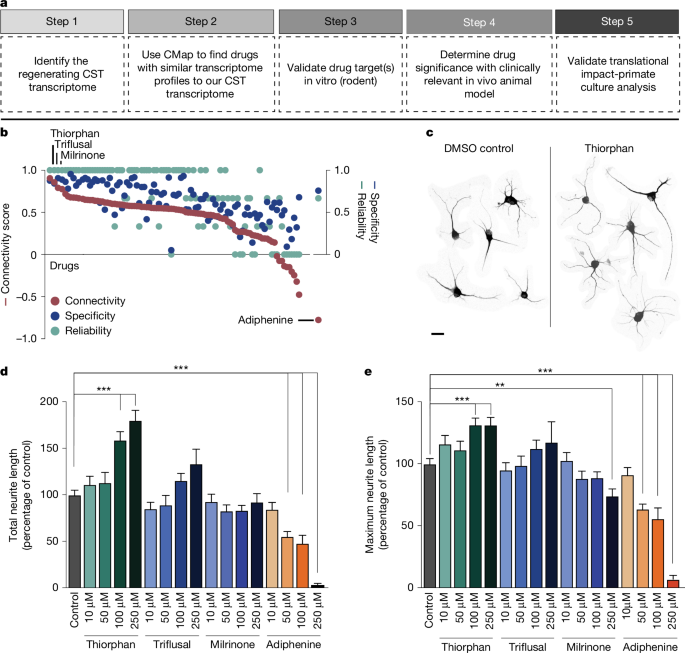Thiorphan reprograms neurons to promote functional recovery after spinal cord injury
Article Meta
Article Date: 29 October 2025
Article URL: https://www.nature.com/articles/s41586-025-09647-y
Article Image: https://media.springernature.com/lw685/springer-static/image/art%3A10.1038%2Fs41586-025-09647-y/MediaObjects/41586_2025_9647_Fig1_HTML.png
Summary
The authors used a five-step discovery pipeline that starts with the transcriptomic signature of regenerating corticospinal neurons, runs an in silico screen against the Connectivity Map (CMap), validates hits in an adult motor cortex neuronal culture assay, tests the lead compound in an in vivo rat model of severe cervical spinal cord injury (SCI), and finally confirms effects in adult primate and human cortical neuron cultures. Thiorphan, a neutral endopeptidase inhibitor previously tested in humans for other indications, emerged as the top candidate. In vitro, thiorphan increased neurite outgrowth and longest neurite length in adult mouse motor cortex cultures. In a severe bilateral C5 contusion rat model, intracortical thiorphan infusion plus neural progenitor cell (NPC) grafting doubled forelimb grasp success and increased corticospinal axon regeneration into grafts by ~60%. Thiorphan also boosted neurite growth in adult macaque and 56-year-old human cortical neurons and shifted gene expression toward developmental, pro-growth programmes; intracortical delivery raised BDNF and phospho-AKT levels. The work highlights a repurposing-ready candidate and a pipeline for CNS drug discovery.
Key Points
- Discovery pipeline: transcriptome signature → CMap in silico screen → adult-neuron in vitro assay → rat in vivo testing → primate/human in vitro validation.
- Thiorphan identified as the top candidate from CMap and adult motor cortex screens; increased total neurite outgrowth (peak ~80% vs control) and longest neurite length in mouse cultures.
- In severe bilateral C5 rat SCI, thiorphan infused into motor cortex + NPC graft produced significant functional recovery (twofold improvement in pellet retrieval) compared with lesion controls.
- Thiorphan increased corticospinal axon regeneration into NPC grafts by ~60% and regenerating axons formed putative synapses with grafted neurons.
- Thiorphan enhanced neurite outgrowth in adult macaque motor cortex and human cortical neurons (56-year-old donor), supporting translational potential.
- RNA-seq in macaque cultures showed 177 genes changed with enrichment for developmental/neurodevelopmental processes; intracortical thiorphan raised BDNF and phospho-AKT.
- Thiorphan does not readily cross the blood–brain barrier, so cortical infusion was used; future work may explore intrathecal, systemic delivery or chemical derivatives with better CNS penetration.
- Because thiorphan has prior human testing for other indications, it may be nearer-term candidate for repurposing if safety and delivery challenges are addressed.
Content summary
The study began with the observation that corticospinal neurons revert to an embryonic-like transcriptional state after injury, a state permissive for axon growth. Using that regenerating signature, the team mined CMap to find compounds that induce similar transcriptomic shifts. Leads were tested in a recently developed medium-throughput assay using adult motor cortex neurons — a more predictive in vitro model than embryonic or immortalised cells. Thiorphan stood out and was advanced to in vivo testing in a clinically relevant severe mid-cervical contusion model in adult rats, with drug delivery started two weeks post-injury to mimic a realistic intervention window.
Rats received one of four treatments: lesion only, thiorphan only (intracortical infusion), NPC graft only, or thiorphan + NPC graft. The combination group showed the clearest functional benefit on skilled forelimb tasks and improved pellet retrieval accuracy. Anatomical analysis showed increased corticospinal regeneration into grafts and formation of putative synapses. Parallel in vitro experiments in adult macaque and human cortical neurons confirmed thiorphan’s pro-growth effect. RNA-seq of macaque cultures treated with thiorphan implicated developmental programmes, and immunolabelling in thiorphan-treated rat cortex revealed elevated BDNF and pAKT, consistent with a pro-regenerative state.
Context and relevance
Spinal cord injury currently lacks effective therapies to restore motor function. This work is important because it uses a targeted, transcriptome-guided repurposing approach that focuses on the corticospinal system — the key motor pathway for voluntary movement in humans. The pipeline prioritises compounds already tested in humans, shortening translational timelines. Demonstrating efficacy in adult rodent in vivo models plus activity in adult primate and human neurons strengthens clinical relevance. The finding that thiorphan amplifies the benefit of NPC grafts suggests combination strategies may be required to produce meaningful recovery in severe injuries.
Why should I read this?
Quick take: if you care about real progress on spinal cord repair, this paper’s a belter. They’ve taken a smart ‘signature → screen → validate’ route and pulled a repurposing candidate that actually boosts regrowth and function — and it works in human neurons in a dish. It’s not a cure yet, but it’s a practical, near-term lead that could speed trials of combination therapies. Worth a read if you’re into neuro-repair, translational neuroscience or drug repurposing.

